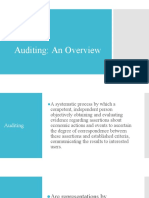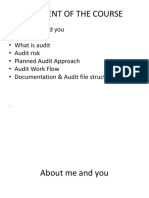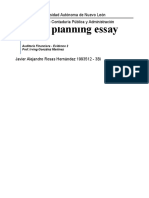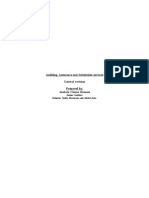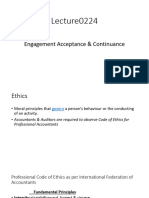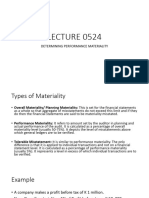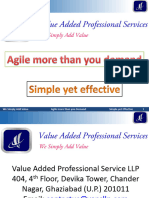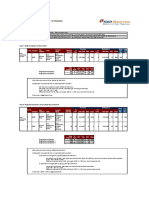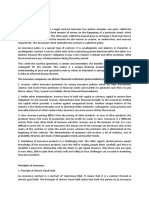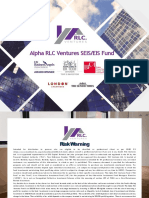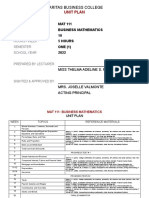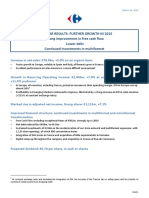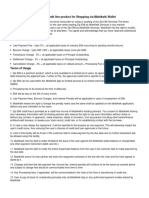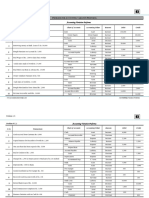0% found this document useful (0 votes)
43 views20 pagesLecture 0324
The document discusses an overall audit strategy which involves planning audits to ensure they are conducted efficiently and effectively. It covers key considerations like scope and timing of audits. Audit plans are tailored for specific areas and procedures are designed to obtain sufficient evidence to reasonably state if financial statements are free from material misstatements, while reducing audit risk to an acceptable level.
Uploaded by
jasonnumahnalkelCopyright
© © All Rights Reserved
We take content rights seriously. If you suspect this is your content, claim it here.
Available Formats
Download as PDF, TXT or read online on Scribd
0% found this document useful (0 votes)
43 views20 pagesLecture 0324
The document discusses an overall audit strategy which involves planning audits to ensure they are conducted efficiently and effectively. It covers key considerations like scope and timing of audits. Audit plans are tailored for specific areas and procedures are designed to obtain sufficient evidence to reasonably state if financial statements are free from material misstatements, while reducing audit risk to an acceptable level.
Uploaded by
jasonnumahnalkelCopyright
© © All Rights Reserved
We take content rights seriously. If you suspect this is your content, claim it here.
Available Formats
Download as PDF, TXT or read online on Scribd
/ 20
Lecture0324
Overall Audit Strategy
Overall Audit Strategy
• Audit Planning is done to ensure audit is conducted efficiently &
effectively hence reduce audit risk to an acceptably low level
• Not a discrete phase
• Continual & iterative process until completion of audit
• Iterative process
• Overarching Plan
• Based on the Overall Audit Strategy the tailored audit plans are
developed
• We will look at the tailored audit plans in Phase II Risk Response
Key Considerations
• The scope of the audit – What are we going to audit. E.g. The financial
Statements
• Timing of the audit – When are we going to audit the financial
statements. Is it throughout the year, at the end of the year or some
throughout the year and some at the end of the year.
• Direction – How are we going to perform the audit.
Audit Plans
• Audit plans are tailored to specific areas
• Contains specific steps to be taken
• And each area has its own plan
• The results of these plans tell you whether there is a material
misstatement or not
• E.g. An audit plan tailored to verify the figure of inventory in the
balance sheet against actual inventory levels.
• Each audit plan for each account balance. E.g. Accounts Payable,
Fixed Assets, cash, etc
Reasonable Assurance
• Audit is done to see if client’s financial statements are free from
Material Misstatements
• Reasonable assurance is high level assurance regarding material
misstatement
• You cannot give absolute assurance as your procedures are not
designed to cover all transactions, account balances & disclosures
• Therefore there is a remote chance of material misstatements not
being detected
• In order to provide reasonable assurance you obtain sufficient
appropriate audit evidence
• And you do that to reduce audit risk to an acceptably low level
Sufficient Appropriate Audit Evidence
• Audit team has gathered enough evidence to reasonably state that
the financial statements are free from material misstatement.
• Sufficiency addresses the quantity of audit evidence. E.g. the sample
chosen should be large enough to be representative
• While appropriate addresses the quality (relevance and reliability) of
audit evidence.
Audit Risk
• Auditor expresses an inappropriate audit opinion when the financial
statements are materially misstated
• Audit Risk exists sampling is involved and possibility of auditor making
a mistake in the process of conducting the audit
• Audit Risk is made up of Risk of Material Misstatement and Detection
Risk
• Audit Risk = Risk of Material Misstatement x Detection Risk
Objective is to set the Audit Risk Low
•Audit risk must be low
•This is to prevent being sued by the client
•It is set by the Partner
•E.g. (A) Audit Risk at 5% - 95 % confident with the audit
(B) Audit Risk at 10% - 90 % confident with the audit
(C) Audit Risk at 15% - 85 % confident with the audit
(D) Audit Risk at 0% - 100% confident with the audit (audit
everything) (it doesn’t happen)
They set this by understanding how risky the client is after conducting the
preliminary activities.
Audit Risk Model
Inherent Risks
• Risks that are naturally associated with the systems, processes or
operations
• They are considered without any internal controls
• E.g. Manufacturing Sector: Inherent risk in a manufacturing process
may involve equipment failure, supply chain disruptions, and product
quality issues.
• Information Technology: Inherent risk in IT operations may
encompass cybersecurity threats, data breaches, and system
vulnerabilities.
Factors affecting Account Inherent Risks
• Balance of the account. E.g. risk associated with revenue of K 50
million is higher than K 10 million
• Liquidity – high liquid high inherent risk. E.g. Cash is riskier than
accounts receivable
• Volume of Transactions – more transactions equals high inherent risks
• Complexity of transactions
• New accounting pronouncements – trying to comply with the new
pronouncements may result in material misstatements
• Subjective estimates – calculations are based on management
judgment of facts & circumstances and can be biased
Control Risks
• Material Misstatements may not be detected or prevented by the
entity’s internal controls.
• If the control risk is high then there are weak controls and vice-versa.
• You systems are not working properly
• Your policies and procedures are not working properly
• If the control risk is low
• Systems are working well so are policies & procedures
Detection Risk
• The auditor may fail to detect material misstatements in the financial
statements
• The auditor must plan and conduct the audit properly
• If the auditors procedures are insufficient or not properly executed,
the detection risk is higher (missed the mistake)
Financial Statements Comprises
• Classes of Transactions
• Account Balances
• Disclosures
Account Balances
• Account Balances – audit transactions in an account balance
• E.g. Revenue Balance is K 50 million in the P&L – its made of 500
various transactions of sales.
• Fixed Assets is K 20 million in the Balance Sheet – 100 different assets
bought and capitalized or posted to Fixed Assets Account
• Practically, thousands of transactions take place in a day and they get
posted into their respective accounts
Disclosures
• Disclosures – to ensure transparency (all significant information is disclosed so
that users make informed decisions)
• Disclosers are notes to financial statements
• Notes are an integral part of financial statements
• Explain the numbers and help make more sense of them
• Increase transparency and provide valuable information to users
• Explain the numbers and help make more sense
• E.g. Physical sales vs. Online Sales. You reported that your sales is K 1 million. In
the notes you can specify physical sales figure and online sales figure to give a
more clear picture of your sales
• Inventory – FIFO, LIFO, Average Cost Method, etc.
• Depreciation Method used for PP&E – Straight Line or other methods
Assertions relating to Transactions
Transactions includes sales, purchases and wages
• Occurrence – transactions recorded have actually occurred and relate
to the entity
• Completeness – all transactions occurred have been recorded
• Accuracy – amounts and other information relating to the
transactions have been recorded appropriately
• Cut-off – transactions were recorded in the correct accounting period
• Classification – transactions have been recorded in the proper
accounts
Assertions Relating to Account Balances
• Account balances includes assets, liabilities & equity
• Existence – assets, liabilities and equity interests exist.
• Rights and obligations – the entity holds or controls rights to assets,
and liabilities are obligations of the entity.
• Completeness – all assets, liabilities and equity interests that should
have been recorded have been recorded
• Accuracy, valuation and allocation – assets, liabilities and equity
interests have been recorded at appropriate amounts
ENDS
